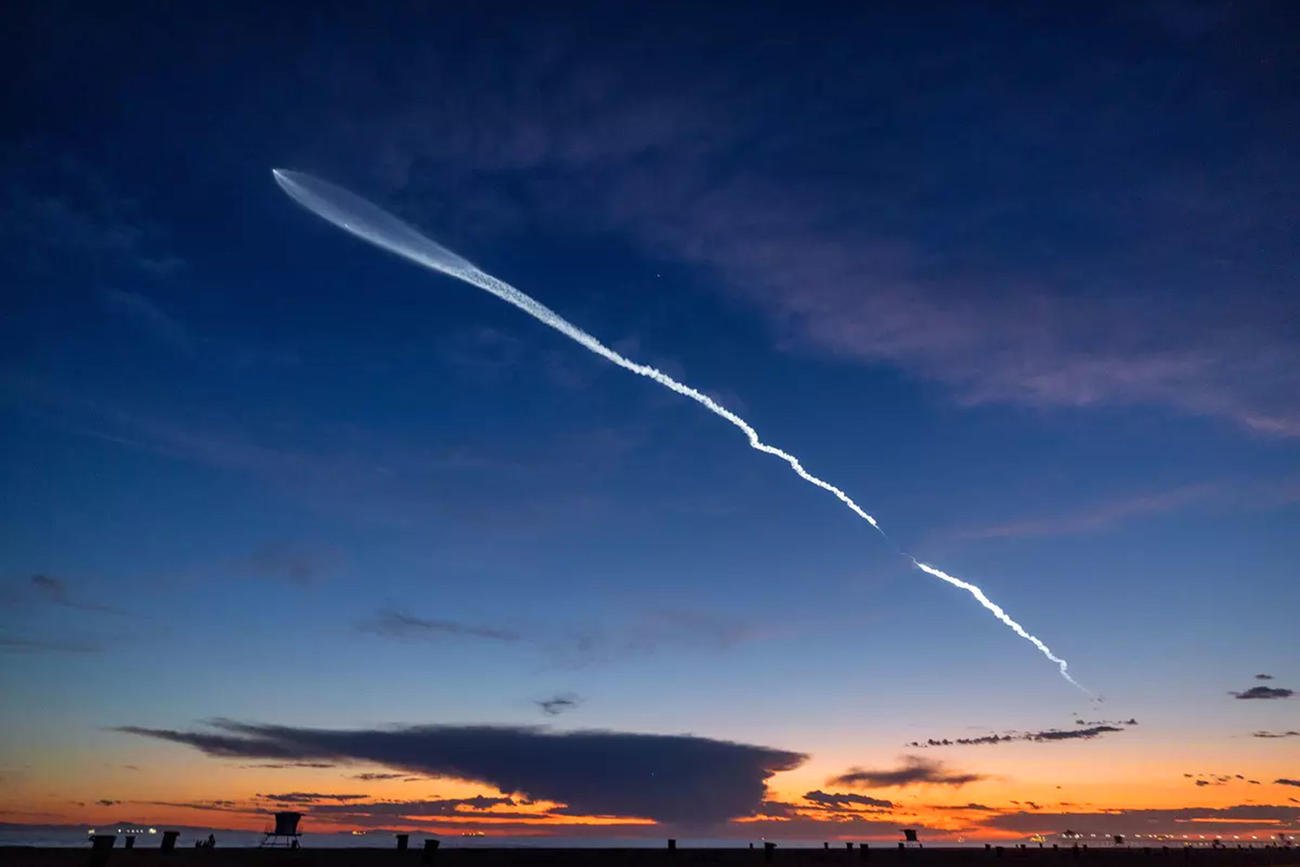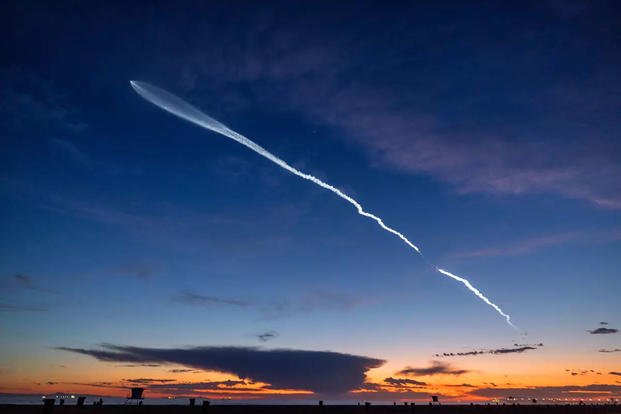

LOS ANGELES — The house jolts and rumbles, and then there’s the unmistakable boom that Mikayla Shocks has been hearing more and more frequently from her Camarillo home.
“One time, I thought a car hit my house,” the mother of four said. “It’s felt by everyone. We hear the boom. My dog freaks out.”
It took a few such incidents and a bit of internet sleuthing before Shocks found the source: sonic booms from rockets launching from Vandenberg Space Force Base.
Space Force officials previously claimed such incidents were rare, and that sonic booms from rocket launches and landings had little effect on the coast.
But the U.S. Air Force now admits what thousands of residents, from Lompoc to Camarillo, have known for months — sonic booms from Vandenberg Space Base regularly rattle a large swath of Southern California, startling residents and wildlife across more than 100 miles of coastline.
The reach of the sonic booms across three Southern California counties was first revealed in a new report from the Air Force to the California Coastal Commission, which is reviewing the military’s plan to significantly increase the number of rocket launches from the base.
Space Force officials say rockets from the base recently have been flying a different path, changing the area that’s affected by sonic booms the rockets generate.
“Recent changes in flight trajectories have made sonic booms audible to individuals living in southern Santa Barbara, Ventura, or northern L.A. counties along the coast,” Col. Mark Shoemaker, Space Launch Delta 30 commander, said in an email to The Times.
Previous models, environmental studies and reports from the U.S. Space Force suggested that sonic booms would be generated out at sea and over the Channel Islands, leaving the coast and most residents living far from the base unaffected.
That is not the case now.
“As launches have become safer and more reliable,” Shoemaker said, “the Federal Aviation Administration and Space Force have allowed a wider range of headings that do not pose risks to public safety but inadvertently resulted in sonic booms over land.”
For some residents, the sonic booms and the increasing number of rocket blasts have had an effect on their lives. Once rare, they are occurring regularly.
The intensity varies with each launch and landing, but Camarillo resident Shocks said the force of the sonic booms that reach her home often have neighbors texting one another the same question: “Is that an earthquake or a launch?”
The new report acknowledging the reach of sonic booms comes after officials at the base also disclosed plans to significantly ramp up the number of rocket launches, tripling blast-offs from about 40 in 2023 to more than 120 launches in 2026.
Four companies launch rockets from the base, including SpaceX, Firefly, United Launch Alliance and Phantom Space, but according to launch estimates from military officials, only SpaceX plans to drastically increase the number of its launches in the next two years.
By 2026, the aerospace company owned by billionaire Elon Musk is looking to blast at least 90 rockets into space each year from Vandenberg. For now, the company and the Space Force are asking the commission to approve 36 launches this year.
Those plans have the California Coastal Commission, tasked with protecting the state’s coastal resources, taking a second look at the rocket launches. The commission is asking the Space Force how the plans to multiply the number of SpaceX rocket launches could affect neighborhoods and wildlife along the coast — particularly in light of the wider area of coastline affected by sonic booms.
‘We get the vibration, then the boom’
Sitting on the coast in Santa Barbara County, Vandenberg Space Force Base is located at the heart of California’s Central Coast, about 155 miles north of Los Angeles. There, military officials said, weather conditions can affect how far a sonic boom might travel.
“The marine layer results in a temperature inversion, which can cause sound waves to refract, or bend the sound waves back,” the report states, citing the Air Force. “Conditions such as cloud cover, fog, and rain attenuate sound waves as it passes through.”
Although the blast of the rockets might be audible only in neighborhoods close to Vandenberg, sonic booms can have a wider reach. A boom occurs when an object travels faster than the speed of sound, releasing a burst of energy that sounds similar to an explosion and can shake and rattle objects in its path.
Just a few weeks ago, military officials said they were unaware of sonic booms reaching residents along the coast.
Col. Bryan Titus, operations vice commander at Vandenberg, told commissioners in April that sonic booms from the base came “not that often.”
The sonic booms, Titus said at the time, occurred when SpaceX rockets landed at Vandenberg, which he said happened about four or five times a year. More often, he said, the rockets return to a landing pad closer to Mexico. Titus, however, assured commissioners, “You’re not going to hear that sonic boom.”
That hasn’t been the experience of Patricia Jacob, who has felt the sonic booms in recent months from her home in Moorpark. The rattling comes so often, she said, that she now monitors SpaceX alerts on social media, hoping she won’t be caught off guard by the blasts.
“We get the vibration, then the boom,” she said.
The sensation, she said, is like a large truck driving by her house.
At first she wasn’t sure where the booms were coming from, she said, until she began to notice the contrails left by SpaceX rockets in the sky. At times, the rocket is still visible, headed out to space.
Then she searched Google Maps to see how far the base was, surprised she would experience the effects nearly 120 miles away.
“I wouldn’t say it’s a nuisance, but if they’re going to up it to so many a year, then it’s a valid question: Is this going to be a problem?” Jacobs said. “It’s relentless — Boom! Boom! Boom!”
Others, such as 61-year-old Rebecca Stebbings of Carpinteria, said they felt like they had to keep track of the launches because they can be unnerving and startling.
“I keep close track of the launch schedule,” she said, “and at times have changed my work schedule in order to be with my dogs so they are not alone in the house when there is a sonic boom.”
She’s been woken up by the booms, which she said she had felt physically, reverberating in her chest.
Concerns about wildlife
The effects of the sonic booms on wildlife are still undetermined, Coastal Commission staff said in a recent report.
The report said military officials had not provided enough information about the sonic booms and the increasing number of launches. The staff also found that previous environmental studies and assurances from the Space Force that wildlife was not negatively affected were now outdated or incomplete, given the wider swath of coastline affected.
But base officials maintain that there still is no change to how wildlife — including protected species — is impacted by the booms.
Space Force officials, in previous reports, have asserted that although some of the wildlife, including sea otters, bats, western snowy plovers, California least terns and red-legged frogs, might startle and flee from their homes and nests after the booms, the overall population has not been affected.
“The Department of Air Force has been monitoring special-status plant and wildlife species for several decades with launch-specific monitoring occurring since the early 1980s,” Shoemaker said, adding that animals tend to hunker down, or they flee the area and then return soon afterward. “These impacts are the same within the larger areas that are impacted by sonic booms.”
California Coastal Commission officials are asking for more information to back those claims.
The commission staff report also noted a launch on April 2, 2023, after which dead harbor seal pups were found. They may have been trampled by other seals fleeing the area after the launch.
Space Force officials said they planned to continue working with the commission and would provide more information. The agency also has updated the Air Force Connect app, on which users can get push notifications about upcoming launches.
Commission officials declined to be interviewed for this story and referred a Times reporter to the staff report and previous public meetings.
Are all SpaceX rocket launches federal activity?
Now the Space Force, which is organized under the Air Force, is seeking an agreement with the commission to increase the number of rocket launches. As a federal agency, the Space Force doesn’t have to seek a permit from the state commission, but the federal and state agencies work toward an agreement to mitigate or avoid negative impacts to the coast and wildlife.
Because SpaceX is a government contractor, the Space Force also has argued that all launch operations by the company should be considered federal activities.
Shoemaker said the issue is “key” to Space Force strategy “as we prepare for strategic competition with great powers and shape the global security environment.” He also stressed the importance of commercial satellites — which SpaceX launches for its satellite internet company, Starlink — saying they support “U.S. government and military needs, including weather, communication and observation.”
It’s a determination that could have far-reaching consequences, placing the state commission and the Department of Defense at odds while private companies, and countries, vie for a technological advantage in space.
Coastal development and other activity that might affect the coast require private entities to obtain a permit from the commission. Federal agencies, on the other hand, are tasked with reaching a “consistency determination” — sort of an agreement with the commission.
If an agreement is not reached, however, federal agencies such as the Space Force could still move forward with the launches, prompting what could be a legal fight in courts or mediation efforts between the two bodies.
Members of the California Coastal Commission are now questioning, with the increased rocket activity, whether SpaceX should be required to obtain a permit instead of bypassing the process if the launches are considered federal activity.
Of the last 71 SpaceX rockets that have been launched from Vandenberg Space Force Base from 2018 to this month, only nine to 14 have carried a government payload, according to a report from commission staff. That means 13% to 20% of launches have involved Department of Defense activity.
The vast majority of SpaceX launches from the military base have carried Starlink satellites and other private payloads, profiting SpaceX and Starlink, which are both owned by Musk.
SpaceX, in an email to The Times, said the question of whether all of the company’s launches should be considered federal activity, including those not carrying government payloads, “fundamentally misunderstands the relationship between the U.S. government and U.S. commercial space launch operators.”
The company contends that all launches occurring out of the military base are federal activities and that all launches benefit the U.S. government, including private satellites, which SpaceX says benefit communications capabilities of different branches of the Department of Defense.
According to Shoemaker, Starlink satellite communication services extend to the Air Force, Navy, Coast Guard and Allied forces.
“The ability to use commercial launch architecture from a myriad of commercial partners provides the U.S. invaluable access to space and a competitive edge during a time of Great Power Competition,” he said.
The California Coastal Commission is set to meet Wednesday to discuss the issue.
___
©2024 Los Angeles Times. Visit at latimes.com. Distributed by Tribune Content Agency, LLC.
© Copyright 2024 The Los Angeles Times. All rights reserved. This material may not be published, broadcast, rewritten or redistributed.
